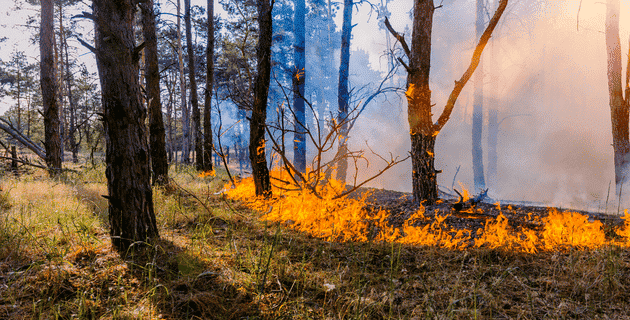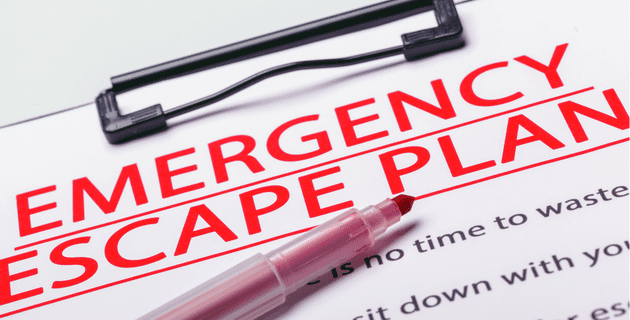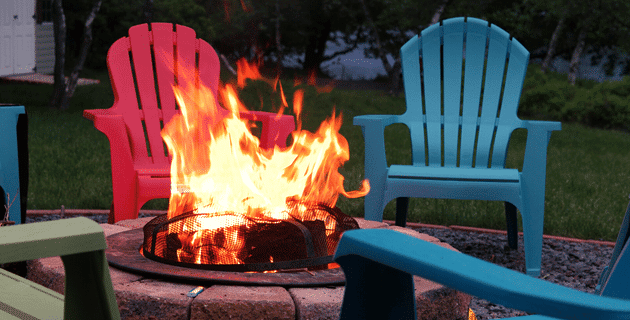
by California Casualty | Homeowners Insurance Info |
When the weather is hot and dry, and conditions are just right, wildfires happen. They are more common in some parts of the country than others, but it’s important to remember a fire can break out anywhere. And when it does, your home and your family are at risk.
Know whether your home is located in a high-risk fire zone and what to do to protect it.
What’s your zone?
A fire hazard zone is a region that has characteristics that put it at higher risk for wildfires, such as:
-
- A history of fires in the region over a 30-50-year period
- Dry, hot, and windy weather that cause fires to spread faster
- Forests and vegetation that act as fuel for fire
- Steep slopes where fire often burns faster
- The potential for fires to burn through the top layer of foliage
- Burning embers that could spread to urban areas
Millions of homes are located in or near fire hazard severity zones. U.S. states most impacted by wildfires include California, Oregon, and Arizona. California has classified its fire zones as moderate, high, and very high. These areas are mapped by the California Department of Forestry and Fire Protection. The zones help property owners and builders better protect structures in areas at high risk.
Other states also affected by recent wildfires include Washington, Colorado, Montana, Wyoming, Utah, Idaho, Nevada, Texas, Alaska, New Mexico, Oklahoma, and Florida. There’s been a population boom in these drought-sensitive regions, which means there’s an increased risk of human activity sparking a fire.
The nonprofit, First Street Foundation, has an online risk factor tool where you can search for your region’s fire risk. You also can find information from your state’s Department of Forestry. If your home is in a fire hazard zone, make sure that your community is an active Firewise USA® site working with local foresters to reduce risks.
How can you protect your home?
In addition to your community working to reduce risk, there are steps you can take to help better protect your home from wildfires.
The USDA Forest Service has divided your home and property into three zones based on research into how homes ignite. Addressing each of these zones will help to reduce the risk of a fire on your property.
Immediate Zone (Less than 5 feet) – your home and the area immediately surrounding it
-
- Seal your windows and doors to reduce the risk of embers getting inside your home. (Embers are burning pieces of wood that can be carried by winds for more than a mile.)
- Use insulated glass, which can hold heat longer than standard glass.
- Avoid acrylic skylights that could melt.
- Paint decking with fireproof paint.
- Consider other fireproof materials, from siding to roofing to metal or fiber-cement doors.
- Declutter the gutter.
- Replace missing shingles on roofs, to protect against embers.
- Install 1/8-inch metal mesh screening in exterior attic vents, also to protect against embers.
- Remove any flammable materials, including leaves, plants, or stored items away from your home’s exterior walls and from under decks or porches.
- Trim branches that hang over your home.
- Consider the installation of sprinkler heads on your roof, patio, or deck.
Intermediate Zone (5-30 feet) – landscaping and hardscaping around your home
-
- Slow the spread of fire toward your home with driveways and walkways to allow a safe area for firefighters to be able to fight the fire.
- Remove flammable vegetation and replace with stones or drought-resistant plants with high water content.
- Use crushed stone or gravel rather than flammable mulches.
- Remove vegetation underneath trees that could help the trees catch fire.
- Space trees in clusters that are 18 feet between the trees’ crowns. If there’s a slope, increase that distance.
- Keep the grass mowed short, to four inches.
- Emergency vehicles need driveways that are 12 feet wide and have a vertical clearance of 15 feet. Check that your property can accommodate them.
Extended Zone (30-100 feet) – the vegetation and land that extends 30 feet past your house
-
- Keep trees at least 12 feet apart (between canopy crowns) within 30-60 feet of your home. Keep trees at least 6 feet apart within 60-100 feet of your home.
- Pick up debris and dead plant material.
- Remove vegetation that is near storage sheds or other structures.
- Make sure your home and street are clearly marked for first responders.
Finally…
This article is furnished by California Casualty, providing auto and home insurance to educators, law enforcement officers, firefighters, and nurses. Get a quote at 1.866.704.8614 or www.calcas.com.

by California Casualty | Safety |
When disaster strikes, you may have only minutes to gather your loved ones, your pets, and your belongings, and get on the road. Are you ready?
Whether it’s a flood, fire, or other emergency, there are times when evacuations are necessary. These are often stressful times when you need to move quickly, and might not have time to grab everything you need. Preparing for emergency evacuations ahead of time will help you and your family know exactly what to do, and what to bring with you, in times of crisis.
Here’s what you need to consider when planning to evacuate.
Learn about local disasters and policies.
-
- Your place of work, your children’s school or daycare, and your local community probably have evacuation plans. You’ll want to find out about them, so that you can incorporate that information in your plan if it applies. Ask these places how they communicate about disaster procedures and what their policies are for emergencies and evacuations.
Pack it up.
-
- Pack an emergency kit full of essential items and documentation your family will need that’s ready to go and keep it in a place where you can grab it easily. Make sure it’s one you can carry or transport easily if you have to walk long distances or travel on public transportation in an emergency.
- Pro Tip: Revisit the content of your kit every six months. That’s when food may expire and children’s clothing sizes may change.
-
- You will need nonperishable food, bottled water, and supplies for 3 days. This includes soap, hand sanitizer, disinfecting wipes, and prescription medications. Make sure you include supplies for pets or infants, such as food and formula, and for any special dietary needs for members of your family. Also pack clothes and pajamas for every member of your family, as well as any bedding, pillows and sleeping bags. Finally, bring a first aid kit and all of your devices and chargers, as well as a battery-powered radio to stay on top of news and information.
-
- Keep a small amount of cash or traveler’s checks at home in a safe place where you can access them in case of evacuation. Store important papers in a fireproof, waterproof container that may be grabbed in case of an emergency. These may include birth certificates, marriage certificates, passports, insurance policies, wills and deeds, and even treasured photos.
Plan your escape route.
-
- Plan for the worst-case scenario. You want to make sure that every member of the family can exit your home safely in the event of an active disaster, such as a fire or earthquake.
-
- Draw a floorplan for your home. Use a blank sheet for each floor. Mark 2 escape routes from each room. Hang the drawing at eye level in each child’s room. Make sure children understand the drawings. Do a room tour and point out the exits. Practice using them. Talk about when your children might have to use them.
-
- Plan for which adults are bringing which items packed in the previous section. Dividing the responsibilities will help you get out more quickly.
Know where to go.
-
- Know your options about where you can evacuate. You may choose to evacuate to a shelter in your town, to a local hotel or motel, or to family or friends in another town, away from the danger. It also may depend on the type of disaster. You may not be able to stay local in a widespread flood but might be able to shelter in a hurricane. Download the FEMA App to locate emergency shelters in your area.
-
- If you choose the local shelter, find out the rules. You want to make sure that they can accommodate your family. You’ll also have to make separate arrangements for pets. (See the pet section below.)
-
- Choose destinations in different directions in case the emergency is in one part of town. Have the addresses and phone numbers handy for easy access.
Map it out.
-
- Keep a full tank of gas if evacuation seems necessary. Gas stations may have long lines or not be able to pump during a power outage.
-
- Be familiar with alternate routes in case you cannot take the route you know. Be alert for road hazards, washed-out bridges, and downed power lines. Avoid driving in flooded areas.
-
- Bring a physical map in case you don’t have access to a GPS or if satellites go down or your devices run out of power.
Plan for pets.
-
- You want to protect your pets during a disaster. That means you will need to find them a safe place to shelter, whether it’s with you at a pet-friendly location or at an animal boarding facility. Know that facility’s evacuation plan if they may be in the region.
-
- Pack pet food, leashes, litter boxes, crates, beds, toys, and any other supplies needed by your pet. Bring a copy of updated veterinary records.
-
- Make sure your pet is microchipped and has a proper ID on his or her collar if applicable. Bring a photo of you and your pet together, which can help if for any reason your pet gets separated from you.
Stay in touch.
-
- Establish a place to meet near your home in case you get separated. Choose a place immediately outside (such as the driveway), a little bit further (such as the stop sign at the end of the street), and a location even further (such as the neighborhood grocery store).
-
- Choose an out-of-state contact that you all can call if needed. Update that person when you are evacuating and as you change locations.
Ready, set, go.
Take the 10-minute evacuation challenge. See if you can get your family and belongings in a car in just 10 minutes. Then, practice your evacuation drill regularly.
Finally, check that you have enough insurance to cover your home, car, and possessions in case they are destroyed in a natural disaster or other emergency. You’ll all have peace of mind knowing that you are fully prepared and know exactly what to do.
This article is furnished by California Casualty, providing auto and home insurance to educators, law enforcement officers, firefighters, and nurses. Get a quote at 1.866.704.8614 or www.calcas.com.

by California Casualty | Homeowners Insurance Info |
Dry, hot weather makes the risk of fire especially dangerous in many parts of the country. Even if you’re not in a region prone to wildfires, you could be affected. Fires can happen anywhere, and once they start, they can spread quickly, putting your property and home at risk.
Fire prevention starts in the yard, and there are some simple steps that you can take to protect your home and property.
Fire Prevention Steps to Take for Free
-
- Remove flammable materials from your yard, especially from 5 feet around your home. These include bark mulch, dried leaves, and garden debris. Also, remove any tree branches that hang low and could fall on your house.
- Keep your yard clean by regular raking. Use a steel rake to remove dead grass and leaves and place them on a tarp. Then transfer them into a leaf bag placed far from your house or put them into a fireproof composter.
- Replace your plants with low flammability plants. While no plant is fireproof, there are some plants that are more difficult to ignite due to their high moisture content. These include sedum, succulents, cacti, lilac, and lavender.
- Pro Tip: Highly flammable plants often have gummy sap and/or leaves that carry a strong odor when crushed. It’s probably best to avoid these types of plants.
- Space your plants farther apart so it’s harder for them to ignite each other. Also, keep plants and grass watered regularly. Avoid planting anything that could catch fire and block your escape from windows or doors.
- Do not store anything under your deck that can catch fire. Move any stored wood well away from your house.
- Follow fire pit and barbecue safety when using those items.
Low to Moderate Cost Fire Prevention Adjustments
-
- Remove wooden or plastic garden borders and replace them with stone or corrugated steel landscape edging. Replace mulch with gravel or seashells.
- Cover your eaves or openings in the exterior walls of your home with 1/8-inch metal screens to block embers.
- Install metal gutter guards to keep leaves and pine needles out of gutters. These can become dry and brittle and add fuel to a fire.
- If you have a deck, install metal wire mesh no larger than 1/8 inch to prevent dry leaves from collecting underneath.
- Plant deciduous trees, such as Serviceberry trees, that don’t produce a lot of dead wood. Avoid conifers such as pine, juniper, or spruce trees.
More Costly Fire Prevention Actions
-
- Redo your wooden deck with fire-resistant decking materials.
- Add hardscaping to your property. This can create a break in vegetation that can slow down or stop the spread of a fire. Plan for paths at least 4 feet wide.
- Install concrete retaining walls. These also can help slow or stop a spreading fire.
- Consider fiber cement or aluminum siding which stand up to heat better than their more combustible alternatives such as vinyl. You also can add flame retardants to wood siding or surfaces.
- Add steel exterior shutters to pull down over windows to keep a fire’s heat from shattering the glass. You also can install double or triple-paned windows.
Make sure that you are in the best position to protect your property and your home in case a fire does occur. Here are some ways that you can prepare.
-
- Check your property to ensure that emergency vehicles, including firetrucks, will have easy access to your home and can get close enough to deploy their hoses.
- Keep a hose available in your shed or fire extinguisher on your property away from your house in case you need it.
- Make sure you have smoke detectors on every floor of your home and check them monthly.
- Store extra extension cords nearby in case you need them. They may be useful to power emergency lights after dark.
- Create a family disaster plan so that everyone knows what to do in the event of a fire. Make disaster preparations for your pets as well.
- Make sure you have home insurance that protects against damage caused by natural disasters such as wildfires. The right insurance provides peace of mind in the event of a fire.
This article is furnished by California Casualty, providing auto and home insurance to educators, law enforcement officers, firefighters, and nurses. Get a quote at 1.866.704.8614 or www.calcas.com.

by California Casualty | Educators |
No flights. No long travel days. No hefty price tag. More and more people are trading in their vacations for staycations- vacations at home or close to home.
For teachers, taking time to relax and recharge is important, and a staycation offers the same benefits as a traditional vacation with less stress and at less cost! Intrigued? Let’s get started planning your perfect staycation.
Choose your staycation style.
Whether you’re a foodie, a history buff, a hiker, or a spa-goer, you can find the activities that you enjoy close to home. You might even try something you’ve always wanted to do but never made time for, or opted out due to cost. Now is the time to consider it. When you plan your itinerary locally, you can feel good that you’re supporting local businesses. Following are some thought starters to help you plan.
Pro Tip: Ask about local discounts or during-the-week specials. Many hotels and attractions offer them.
Be a local tourist.
Discover the beauty of your city and region. Book all of the tours and experiences you might enjoy if you were traveling here as a tourist. From museums and cultural experiences to nightlife and entertainment, your local area likely offers plenty of options. You’ll have the added advantage of being a local, and knowing all the good spots to eat.
Indulge in a gourmet adventure.
On a traditional vacation, you’d be eating out. Plan to eat out as much as your budget allows—or else create your own special meals at home. Picnic in the park. Book an afternoon tea. Try that new gourmet place or find a food truck festival. The options are endless and delicious!
Hit the beach or pool.
If you’re lucky enough to live near a beach, that’s a natural destination. But if not, consider a staycation at a local hotel or lodging with a pool (or even a jacuzzi tub!). Bring your swimsuit, grab a favorite beach read and soak up those rays.
Relax at the spa.
There’s nothing like a spa day to relax and unwind. Go ahead and get that facial and massage. Spend some time in the hot tub or sauna. Many spas let you spend the day if you book a service, and some offer food and other amenities.
Take a hike.
Put on your hiking shoes. If you’re a nature lover, you’ll enjoy exploring your local trails and other outdoor adventures. Spending time in nature is great for your mental health, and the exercise is great for your physical health. Not to mention that the scenery is definitely photo-worthy!
Take a course.
If you’ve always wanted to learn how to make pottery or you love to get your hands dirty in the garden, chances are that there’s a course you can take to explore this interest. Find out what’s offered in your local region. Check your local community college and township recreation schedule. Airbnb also has many local experiences that you could book for an hour or more.
While not strictly a staycation, you can carve out time during break to redecorate a room or spot in your home. Do-it-yourself makeovers can be plenty of fun. Just keep them manageable, and plan some time away from the work to create a relaxing staycation feel.
Try virtual tourism.
You may not be able to travel the world but you can bring the world to you with some virtual tourism activities. Expedia offers some online tours and activities from cooking classes to video chats with locals, and museum tours.
For other ideas, check out our blog on ideas for your spring break staycation.
Avoid self-sabotage.
The point of a staycation is to get away. That’s a little harder to do when you are home and tempted by housework or work. (That’s especially true since our homes have doubled as workspaces over the past several years.) Here are some tips to help you fully disconnect.
-
- Set boundaries. If school is in session, plan work coverage. Make sure everyone who is part of your staycation plans coverage, too.
- Hire a dog walker. If you have fur babies at home but you’ll be out and about, make arrangements for their care.
- Unplug. Turn off your phone notifications and email. Make sure that work and family obligations do not interrupt your time off. (However, give family a way to reach you in the event of an emergency.)
- Plan each day fully so there’s no downtime to worry about day-to-day responsibilities. Note the time, upon your return, when you will address these.
Remember that you don’t have to stay home during a staycation. Consider one or two nights at a local hotel or other lodging. And be sure to ask for local discounts!
Don’t forget that Educators & ESPs can win a $10,000 Staycation Giveaway from California Casualty! Let us help you escape the every day with $10,000 to spend your way.
Get that hot tub you’ve always wanted, create your dream kitchen, turn your backyard into an oasis, add a media room the whole family can enjoy. Or just take the money and do what YOU want. The possibilities are endless!
Click HERE to enter.
This article is furnished by California Casualty, providing auto and home insurance to educators, law enforcement officers, firefighters, and nurses. Get a quote at 1.866.704.8614 or www.calcas.com.

by California Casualty | Homeowners Insurance Info, Safety |
School’s out, which means if your child is old enough, he or she may find themselves home alone without you. Navigating the house on their own, or with a babysitter, can definitely help kids build independence. However, you also want to make sure they’re safe.
For those times when your child may be home alone or with a babysitter, here’s a list of important summer safety tips.
Lesson 1: Basic First Aid
Decide what first aid your child may be capable of providing. If he or she gets a small cut or scrape, for example, your child can clean the wound and put on a band-aid.
What You Can Do: Prepare a first aid kit with those supplies that you would like him/her to use for such things as minor cuts, scrapes, and burns. Go over the items in the first aid kit and show your child how to use them. Then have your child role-play and practice with them. Discuss when they might need to call for help if the injury seems more serious than they can treat with the kit.
Pro Tip: If your child has a smartphone or device and is allowed to use it, download the Red Cross First Aid App.
Fire safety at home is important. Fires can be scary but even the sound of the smoke alarm can be frightening.
What You Can Do: Let your child hear the sound so they know what to expect. Then discuss the fact that they need to leave the house and contact a trusted adult such as a neighbor or someone by phone. If there’s an active fire that they see, they can call 9-1-1. Since your child can be anywhere in the house when the smoke alarm goes off, practice how to leave each room. Remember the rule of 2/2/2. Practice two ways out of every room, two times of the day (day and night) at least two times a year.
Lesson 3: Emergency Contact List
Help is just a phone call away. Share the emergency list with your child.
What You Can Do: Post the list of parents’ work and cell numbers, family, and friends who will be available to your child as needed. Include neighbors who can be a nearby onsite resource. The list also should include 9-1-1 for big emergencies (and your house address should the dispatcher need it). However, explain to your child the types of situations that would necessitate dialing 9-1-1.
Pro Tip: Involve your family member or neighbor and have your child give them a quick call to ask if it’s okay to put their names on your call list. That will give your child practice making the call.
Lesson 4: Bad Weather or Emergency Situations
Even in the summer, bad weather can strike. If your child is at home alone or with a sitter and there is a severe storm or another emergency situation, make sure they know what to do.
What You Can Do: Make sure your child or sitter knows how to check the weather, on their phone or your local weather channel, and have them sign up for emergency alerts. Also, make sure they know where you keep your emergency kit if they need to take shelter. Go over the family disaster plan with them so they know exactly who to call and where to go. It’s important to discuss emergency scenarios with your child and sitter before you leave them alone, so they won’t panic and will know exactly what to do.
Lesson 5: Home-Alone Rules
Depending upon your child’s age and maturity, and your own comfort level, set rules for when they are home alone or with a sitter.
What You Can Do: Go over the rules with your child. Practice them and explain their importance. And then write them down as a reference, that they can look at. Here are some rules you may consider.
Limit cooking and stay away from fire sources.
Decide if your child will be allowed to use the stove, microwave, or toaster. If not, make sure there are plenty of cold meal options and snacks. If you do allow cooking of any kind, review the safety rules. Make sure your child knows what materials are dangerous for the microwave, and not to fish out a stuck piece of toast from the toaster with a metal fork. Decide on the rules for knives. Make sure your child doesn’t do anything alone that he or she hasn’t already done successfully under your supervision. Finally, ensure that your child knows where the fire extinguisher is and how to use it in the event of a kitchen fire. (Also, if this happens, your child should call an adult and 9-1-1.)
Keep the house locked and don’t let strangers know you are alone.
Make sure all doors and windows are locked when your child is home alone or with a sitter. If there is a security system that will be set, teach your child how to enable and disable it. Let your son or daughter know not to answer the door, even for delivery people. If someone calls and asks for you, provide a script of what to say; for example, “he or she is busy right now. Can I take a message?” Write that by the phone so your child doesn’t have to remember it. Be clear on whether your child is allowed to leave the house, and under what circumstances. If he or she does leave for any reason, instruct your child to tell you. You should always know where your child is.
Set rules for the phone, computer, smart devices, and TV.
Screen time is a big draw to kids home alone. Set the rules so they know what is allowed and what is not. You may allow gaming but not social media, or a movie marathon but not long text conversations. Make sure your child does not share that they are home alone, whether on social media, text or other interactions.
Specify the way your child will check-in.
You will want reassurance that your child is all right. Ask him or her to check in with you at specified times and in specific ways. Decide whether a text or call will suffice and how often. Make it a rule that they have to answer you right away if you call.
If your child is new to being left alone, start small. Leave for a short errand. Praise your child for following the rules. Continue to model safety practices, and before long, you’ll be surprised at how responsible your child can be when home alone.
This article is furnished by California Casualty, providing auto and home insurance to educators, law enforcement officers, firefighters, and nurses. Get a quote at 1.866.704.8614 or www.calcas.com.





